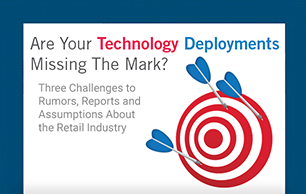At Telaid, we understand that visions of what’s possible today with physical security technology may not match the technology functionality of your current stores. The disparity is not due to a lack of vision, awareness, or even desire, but is often a function of limited budget dollars, resources and a complex network of existing technologies.
 As an example, fully integrated unified physical security platforms that are 100% integrated, cloud-based, automated and keyless may be found in a smattering of state-of-the-art new stores, but do not reflect the current reality for most retailers.
As an example, fully integrated unified physical security platforms that are 100% integrated, cloud-based, automated and keyless may be found in a smattering of state-of-the-art new stores, but do not reflect the current reality for most retailers.
Retailers most often transition to new technologies one system - or even one asset - at a time. The process of bridging the gap from current technology state to desired state can take several months or budget cycles. With these conditions in mind, retailers can keep some best practices top-of-mind to as they shift from independent legacy systems to advanced, fully digitized and integrated physical security platforms.
Reaching the vision does not mean deploying the latest/greatest state-of-the-art system one year and then doing the same for a different system the next year. Sure, selecting great systems that meet your business objectives is part of it, but it’s more subtle and complex than that. To achieve the ultimate in fully automated, integrated physical security systems, it’s important to have a plan in place early on and to consider the future while making changes in the present.
1. Keep an eye on infrastructure
Deploying new technologies haphazardly on existing infrastructure can result in poor performance, an overwhelmed network, missed deadlines and/or expensive rework. It’s critical to evaluate your current infrastructure to ensure it is primed to handle new technologies today and others planned for the future. From cabling to power, Wi-Fi and servers, these “basics” are too often left unplanned, resulting in frustration and expense later. Don’t let your project fail because you did not start with the basics: always evaluate infrastructure.
2. Make the shift to the cloud
With some hesitation, but gradually, physical security applications are moving to the cloud. With benefits including accessibility, flexibility, reduced costs and ease of management, a recent survey indicates that 57 percent of respondents believe that the cloud is a cyber-safe environment for physical security operations.*
When moving to the cloud, keep in mind that your data and systems are still hosted in fundamentally the same way, it’s just being done outside your physical space and servers. All of the same security measures, redundancy efforts, etc., still apply. Prior to selecting a vendor, be sure to ask critical questions. Understand the physical location where your data will be hosted and who will have access to it. Understand measures that will be taken to ensure your data is not inadvertently commingled with other clients’ data. Make sure you can mimic your in-house security measures in the cloud. As with any major network shift, moving to the cloud should be planned meticulously, with attention to staging the shift over time and planning for unified, overarching security measures in the cloud.
3. Bridge the communication gap
LP professionals are used to doing more with less, innovating solutions on the fly, and working independently to accomplish their goals. But increasingly, technologies that were traditionally considered to fall under the exclusive domain of the LP team, are now often managed by IT and of great value to stakeholders across the board. By collaborating with these stakeholders – professionals from marketing and merchandising, operations and customer service – LP can not only become the heroes of their organizations, but can also potentially access additional investment dollars for new camera, access control and RFID technologies that deliver benefit across the board. It’s well worth some effort to begin communicating with others.
4. Keep IT security top of mind
LP’s obvious appreciation for greater security should also apply to issues of cybersecurity. Protecting everything from the wireless network to access to video in the cloud is critical. Understanding your vulnerabilities is the first step to being able to address them. Conduct penetration testing to identify potential security gaps. Considering using sticky MACs, which only allow one device to connect on one particular switch port. For the wireless network, packet sniffers can assist with traffic inspection to remove unwanted traffic from the network. The most important thing is to be proactive. Axis, a provider of cameras, offers some insight into the benefits of device management software on their blog.
At Telaid, we recommend beginning any new technology deployment plan with a site readiness assessment. This thorough assessment works through the details of planning for current and future technology deployments by assessing current infrastructure, equipment inventory, and needs over time. Are you prepared to take your physical security system to the next level?




